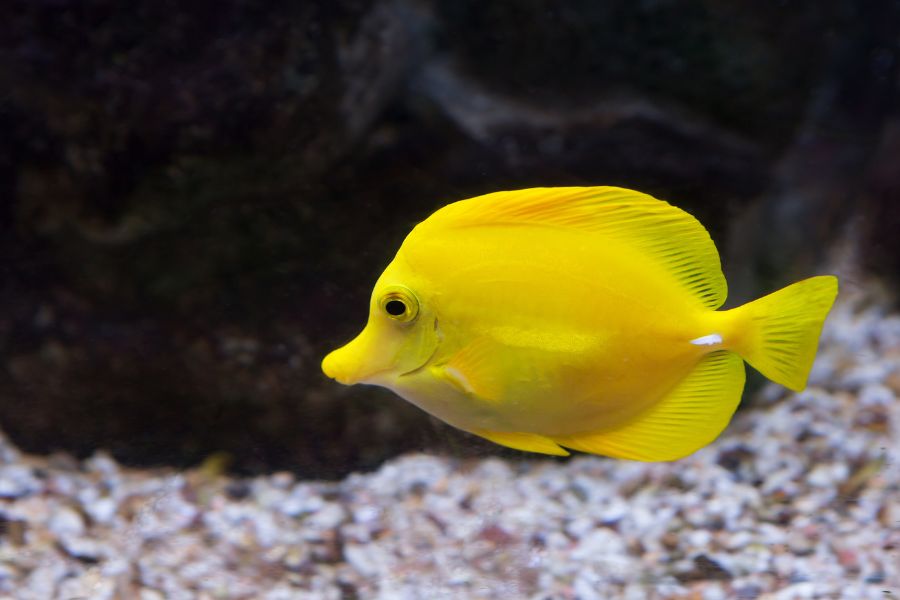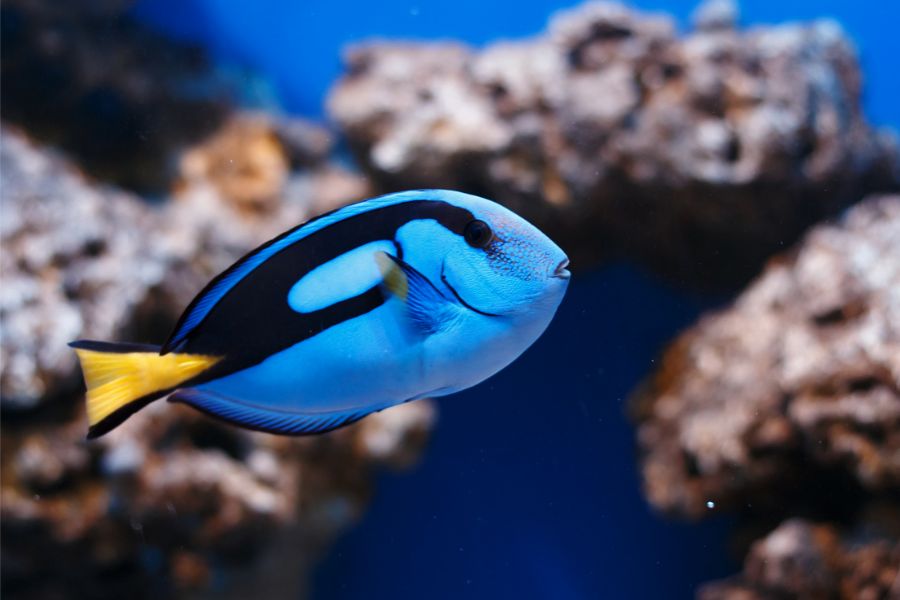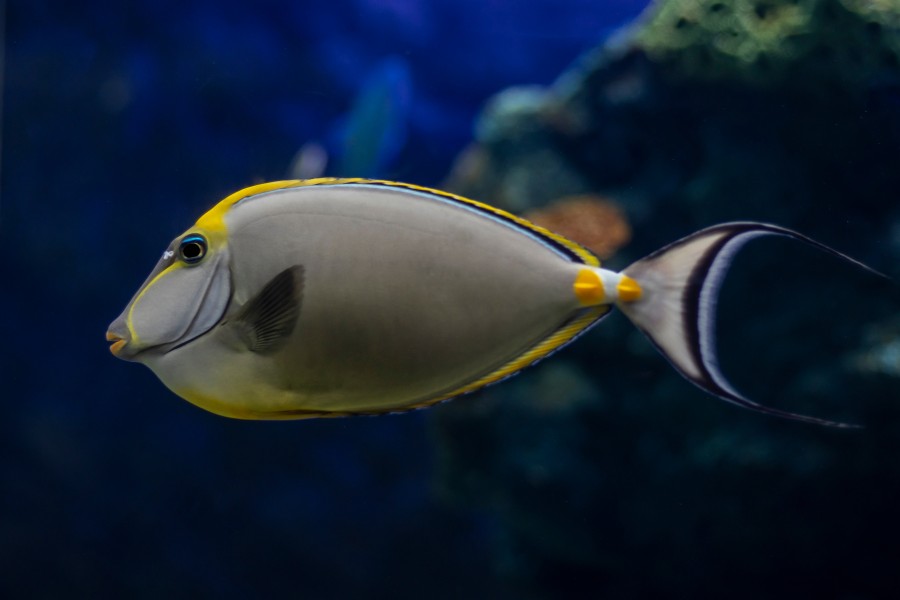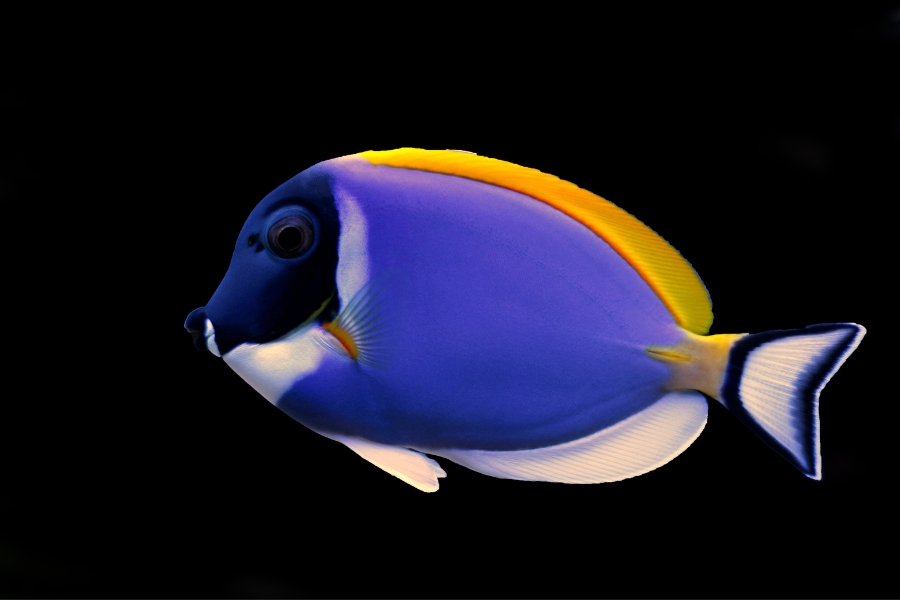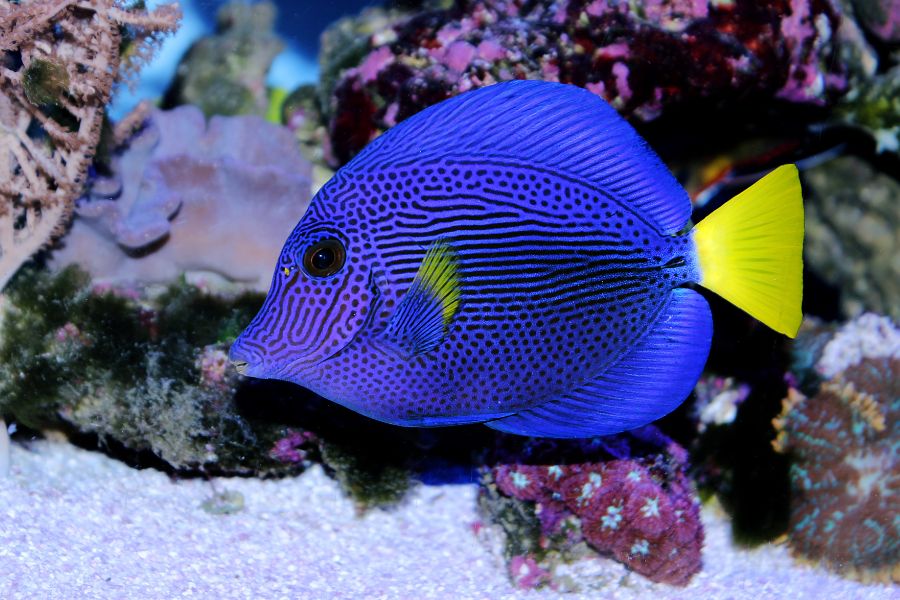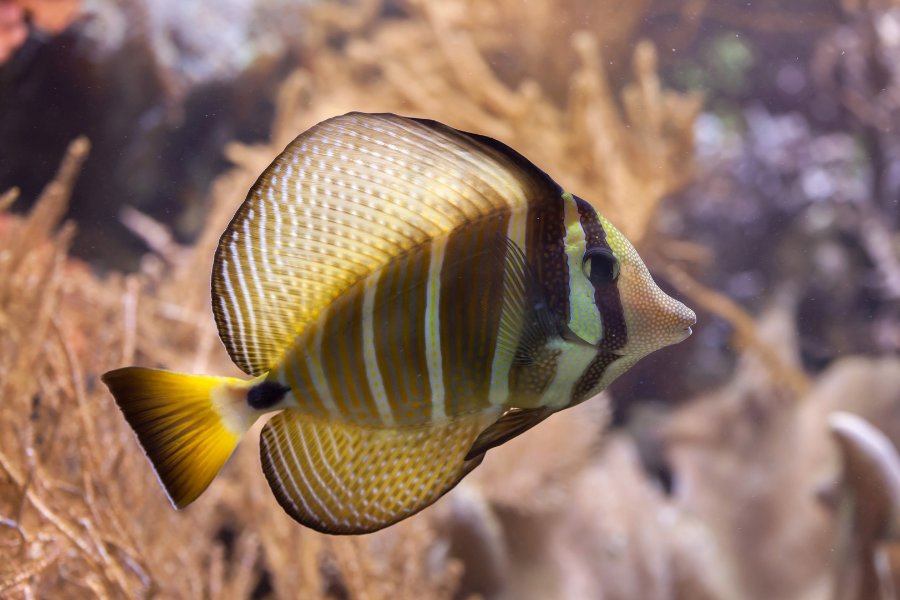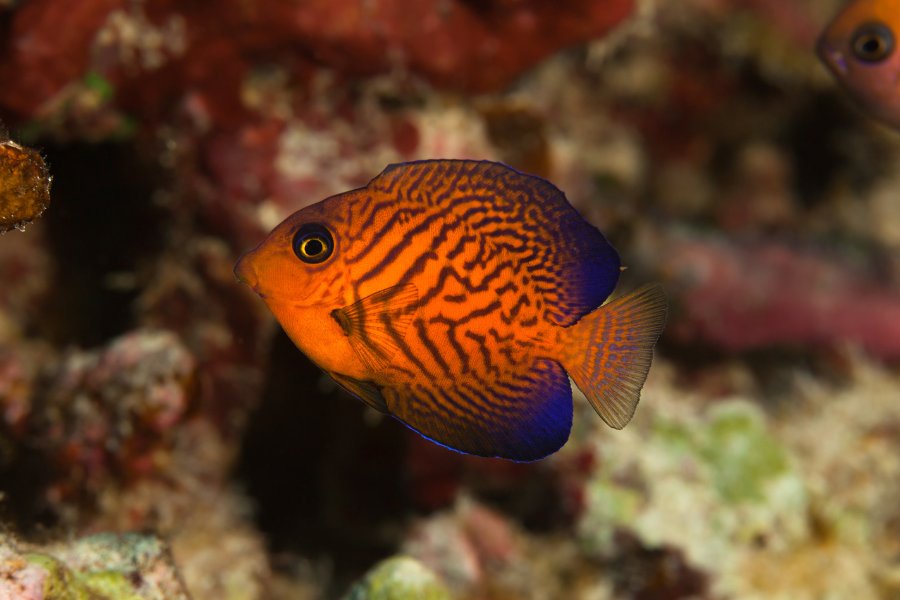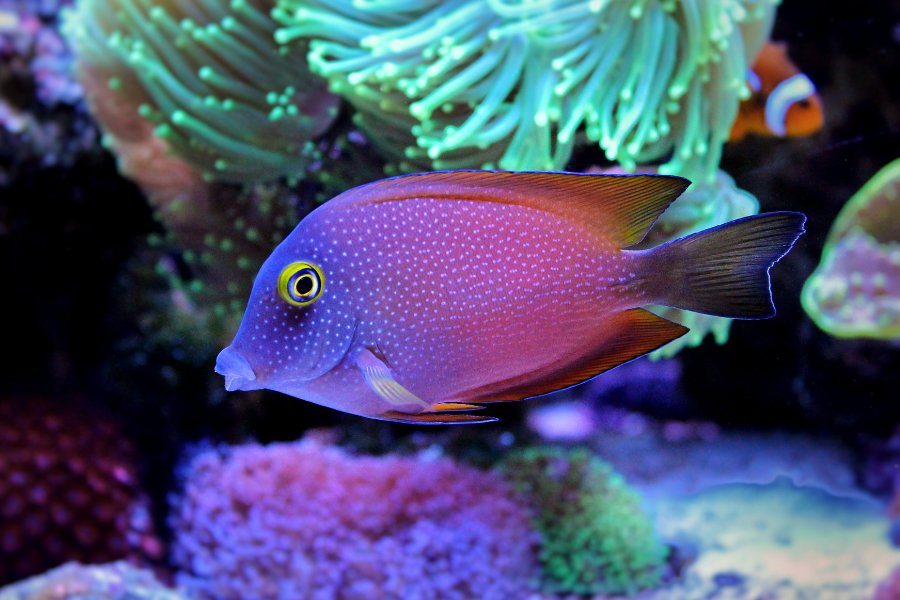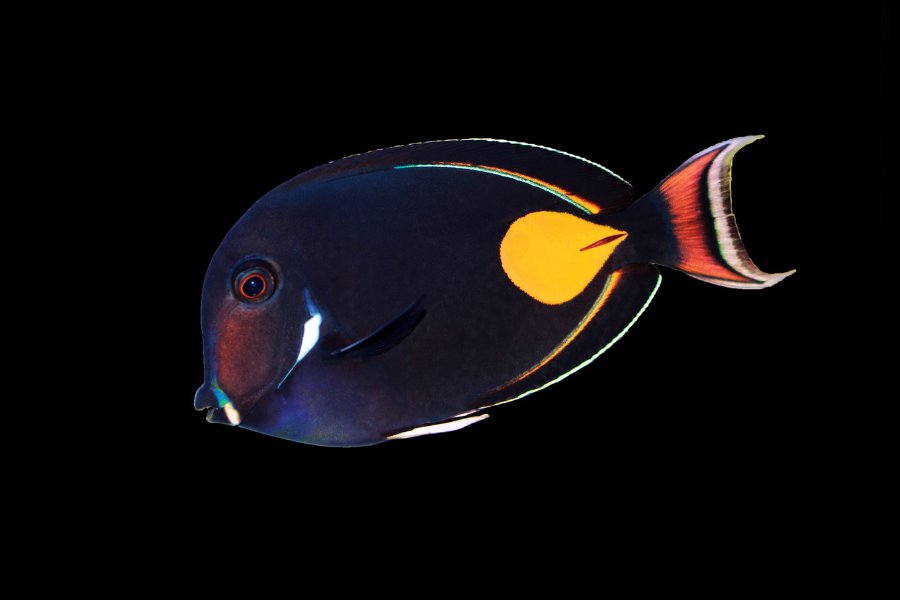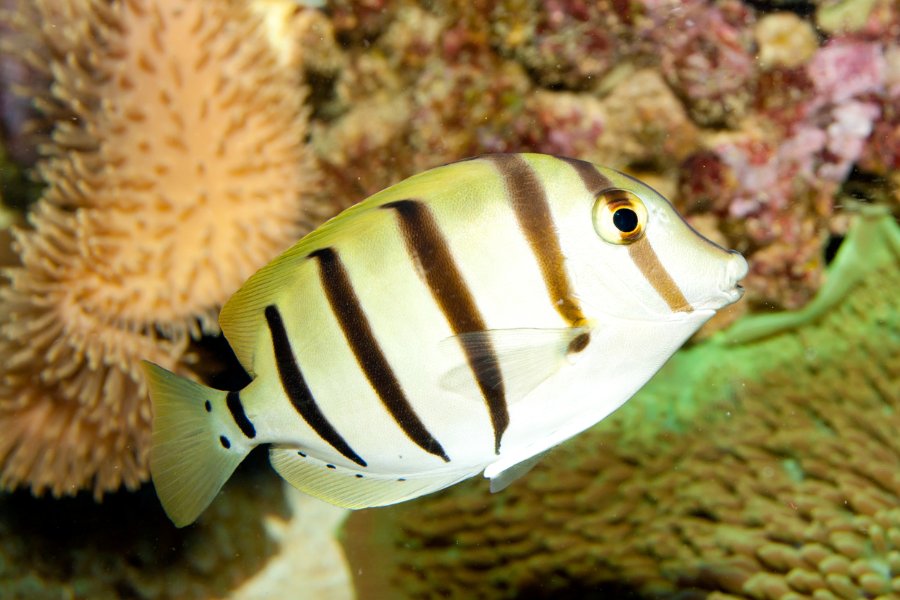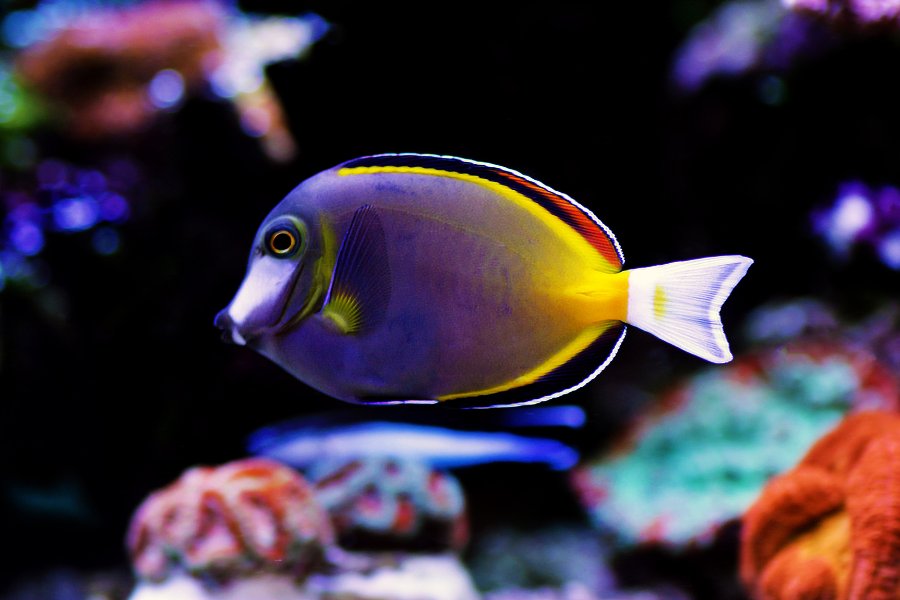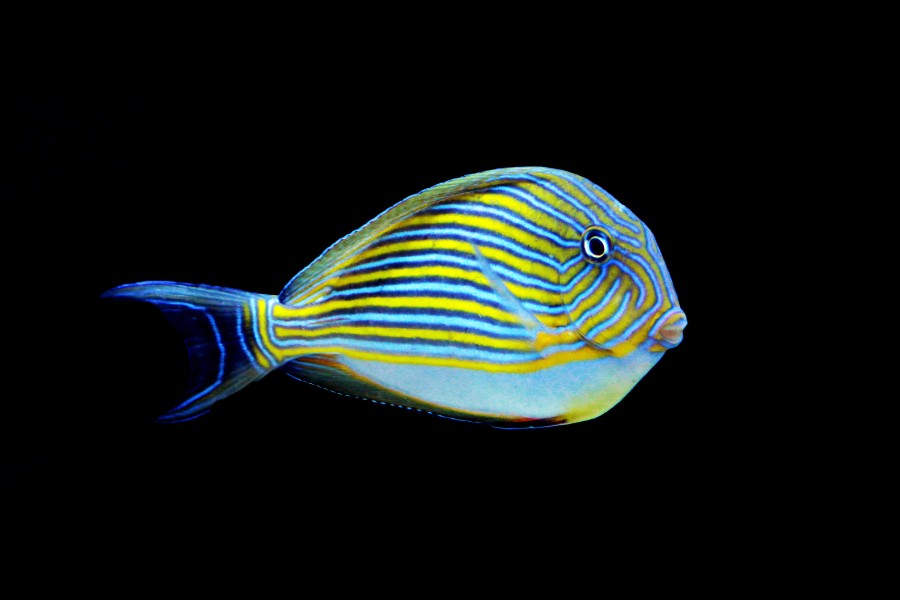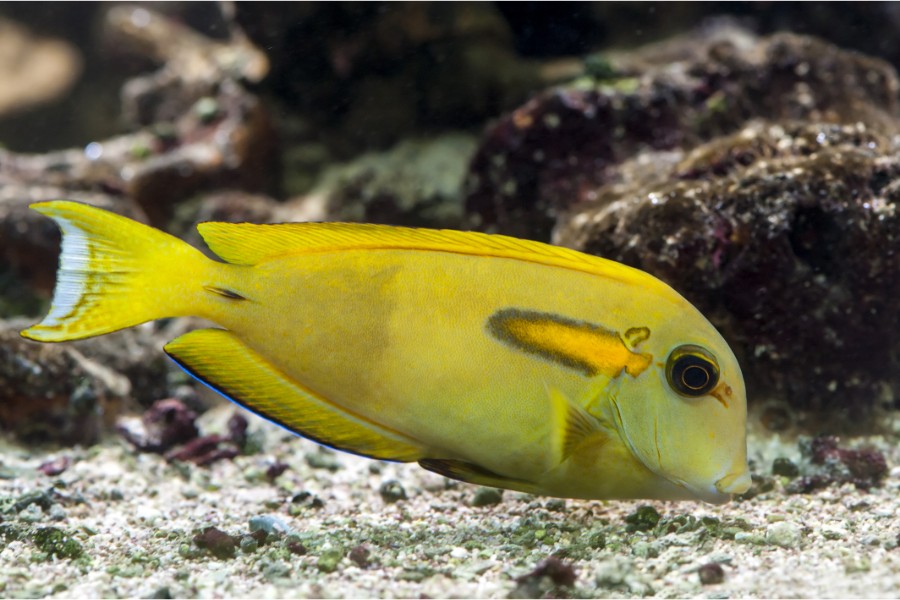Did you know there are over 80 different types of tang fish in the ocean? Tangs come in very many different colors & patterns, enough to cover the entire rainbow spectrum and then some. But as attractive as these marine fish are, they can be quite expensive and hard to come by.
Maybe you want a tang that is popular and easy to care for. Or you are looking for a rare breed with unique colors. Maybe you are an expert and want a more exotic tang. The beauty of this species is that there is something for everyone.
Please note that it is very important to pick the right tang for you.
Some tang fish are more sensitive than others. Others require more maintenance and unique tank mates, while others are manageable. Read on to pick the right tang for your specific aquarium tank.
What Kind of Fish is a Tang
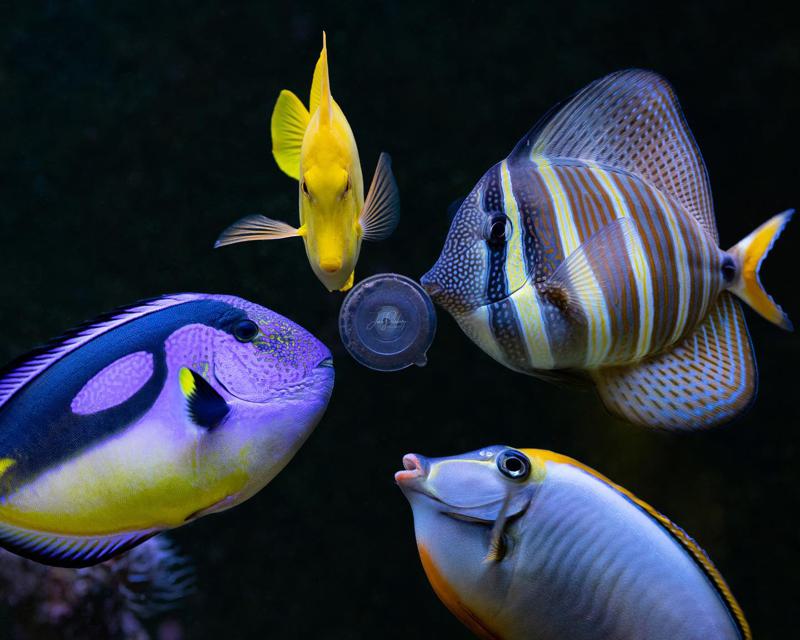
A tang fish is a tropical saltwater fish uniquely known for its scalpels which are attached to both ends of its tail base.
The term ‘tang fish’ is used to describe a wide range of fish belonging to the Acanthuridae family, including surgeonfish, unicornfish, doctorfish, and real tangs.
The Acanthuridae family, derived from Acanthurus, meaning Spiny-tail, have this spine or tang to help them fend for themselves against predators in the wild. However, they are non-territorial & unaggressive fish that can get along with many species.
The twist is that tangs are bullies among their own species. They do not like to share space with other tangs, especially if they look exactly like them.
They do not portray such behavior in the ocean, but when put in captivity, the fish use their scalpels to aggressively and defensively mark their territory.
The good news is you can avoid such behavior by not keeping tang fish with fish that look similar to it. Another good solution is to keep just one single tang in the aquarium tank.
Some great tank mates include the angels and clownfish. However, remember that compatible tank mates will vary depending on the type of tang fish you have.
With over 80 different members, the tangs are spread across the globe from the Atlantic Ocean to the Pacific and Indian Ocean, they are also found in the Caribbean regions.
Physically, the tangs have an iconic disc-shaped fish that is widely known from the Finding Dory and Finding Nemo movies. Dory, in the movies is a blue regal tang fish.
Like Dory, tangs are characterized by sharp scalpels, oval-shaped bodies, bold colors, large bodies (up to 1 foot long), pointed snouts, low-positioned small mouths that are hard and beak-like (used to scrape for algae), continuous dorsal fins, small scales, and small scales.
Tang males are typically larger than their female counterparts, but both sexes can grow up to 1 foot but typically range between 8 – 10 inches. Colors come in all shapes and sizes, from blue tangs to yellow tanks and purple ones.
Tangs breed in groups through broadcast spawning, with females laying, on average, 40,000 eggs. Groups of male tang fish then fertilize the eggs. This is done above coral reefs, which means it will be a good addition to putting similar vegetation in your reef tank.
Proper tank care will increase their lifespan up to 30 years, but they typically live for less than 20 years. Stress, diseases, and bad tank management can reduce the lifespan to just a few weeks, months, or just a couple of years.
Most importantly, tangs are herbivores. Many aquarists have a habit of feeding tangs meaty and fish-based aquarium foods. There is little consequence to this since these foods are nutritious, but it is advisable to stick to their natural diet – plant-based food, marine algae, and zooplankton (on occasion).
13 Most Popular & Beautiful Types of Tang Fish
Tang fishes have very minimal physical variations between their species. They are differentiated based on their varying colors. Regardless of the color type, the tang fish is a vividly attractive fish that will add more oomph to your tank.
The best fish to get are from official local stores or online shops where the tang fish has been raised in captivity. This will not only ensure the fish is adapted to an aquarium lifestyle but also helps you know the best way to take care of your new pet.
Below are the best, easy-to-find, and lovable tang fishes in the markets today:
1. Yellow Tang
| Common Names | Yellow tang, Somber surgeonfish, Yellow sailfin tang |
| Scientific Name | Zebrasoma flavescens |
| Origin | Pacific Ocean, Western Hawaii, Eastern Japan |
| Average Adult Size | 8 – 9 inches |
| Lifespan | Up to 20 years |
| Minimum Tank Size | 55-gallon tank |
| Ideal Temperatures | 72 – 80 degrees Fahrenheit |
| Ideal pH Levels | 8.0 – 8.4 |
| Ease of Care | Easy to moderate |
This is the most popular and well-known tang fish in the aquarium trade. Its bright yellow color and hardy nature makes it a great addition to any aquarium.
It has a distinctive curved body shape and is known to have one of the friendliest personalities. You can expect to buy the yellow tang from as low as $100 for 2 to 4-inch sizes.
Its color is also mesmerizing because it changes at night, the yellow becomes a bit faded, and you can notice a prominent brown patch on the middle of its body.
Also, the male color “shimmers” during the mating season (full moon period), making it easier to differentiate them from the female fish.
The yellow tang’s care is easy to medium, with relatively more needs if you plan to breed them. Keep in mind that tangs spawn in pairs or groups, which translates to a bigger tank (180 gallons minimum), more waste, more food, and more aggression to look out for.
Individually, yellow tangs have a hardy character, resilient body, and minimal food & maintenance needs. Feed the fish some dried and frozen herbivore foods for them to thrive.
2. Pacific Blue Tang
| Common Names | Blue tang, regal blue tang, Hepatus, regal tang, palette surgeonfish |
| Scientific Name | Paracanthurus hepatus |
| Origin | Indian and Pacific Oceans |
| Average Adult Size | 8 – 12 inches |
| Lifespan | 8 – 20 years |
| Minimum Tank Size | 100-gallon tanks |
| Ideal Temperatures | 72 – 79 degrees Fahrenheit |
| Ideal pH Levels | 8.0 – 8.4 |
| Ease of Care | Easy |
Dory from Finding Nemo is a blue tang, specifically the Royal Blue Tang, also known as the Blue Regal Tang from Finding Dory.
What’s not to love? It features a royal blue body with a distinct yellow tail and a black pattern spread across the upper side. They are found in the wild in the Indo-Pacific region and are known to be hardy fish that are easy to care for.
It is another popular tang fish that is known for its vibrant blue color. Another pro is that the fish comes at the same price as the yellow tang.
A great distinction between the blue tang with other tangs is that it needs a bit of a meaty diet. They are prolific zooplankton eaters and cannot thrive without a fair share of the proteins.
3. Naso Tang
| Common Names | Naso, lipstick tang, smooth-head unicornfish, clown surgeonfish, orangespine unicornfish, literate surgeonfish |
| Scientific Name | Naso lituratus |
| Origin | Pacific Oceans |
| Average Adult Size | 9 to 18 inches |
| Lifespan | 8 -18 years |
| Minimum Tank Size | 125-gallon tanks |
| Ideal Temperatures | 72 – 79 degrees Fahrenheit |
| Ideal pH Levels | 8.1 – 8.4 |
| Ease of Care | Medium |
The naso tang is an eye-catcher with a dark grey base color, orange mouth, orange to yellow stripes from the mouth base to the top of the eyes, and a black spot on the upper portion of the gill cover. The dorsal and anal fins are also orange, while the caudal fin is a deep black.
It’s harder to care for the Naso tang because of its massive size and rough demeanor around other tangs and surgeonfish. Keep them with larger species from different families. Also, a tank bigger than 250 gallons will do a better job of giving enough space to the active swimming tangs.
The naso prefers an herbivorous diet and lots of brown microalgae to scrape on in its active cycles.
4. Powder Blue Tang
| Common Names | Powder-blue surgeonfish |
| Scientific Name | Acanthurus leucosternon |
| Origin | Indian Oceans |
| Average Adult Size | 8 – 10 inches |
| Lifespan | Up to 18 years |
| Minimum Tank Size | 90-gallon tanks |
| Ideal Temperatures | 72 – 79 degrees Fahrenheit |
| Ideal pH Levels | 8.0 – 8.4 |
| Ease of Care | Medium to hard |
The powder blue tang color is a vibrant, light blue hue with a slight purple undertone. It is reminiscent of the color of a clear, powdery sky on a sunny day. The color is bright and eye-catching, with a slight iridescence that gives it a shimmering effect.
Like other tangs, it has one dorsal fin. The dorsal fins are yellow, creating a striking contrast against the rest of its body.
Please take caution before getting this fish since it has a tendency to get affected by the HLLE disease and Cryptocaryon.
5. Purple Tang
| Common Names | Yellowtail tang, dusky sailfin tang, yellowtail surgeonfish |
| Scientific Name | Zebrasoma xanthurum |
| Origin | Indian and Pacific Oceans |
| Average Adult Size | 10 inches |
| Lifespan | 20 years |
| Minimum Tank Size | 125-gallon tanks |
| Ideal Temperatures | 72 – 79 degrees Fahrenheit |
| Ideal pH Levels | 8.0 – 8.4 |
| Ease of Care | Medium to hard |
Purple tangs are among the most aggressive in the tang family. It is best if you do not keep them next to other tangs. They love to pick on coral leaves and are prolific algae eaters in the aquarium, something that other tangs only do in the wild.
What makes the fish a great choice is its relatively low price and vibrant, captivating color. It is bluish-purple with a cool undertone that is strongly saturated and rich. All of this is complimented by the fish’s yellow pectoral and tail fins.
6. Sailfin Tang
| Common Names | Pacific sailfin |
| Scientific Name | Zebrasoma velifer |
| Origin | Pacific Oceans |
| Average Adult Size | Up to 16 inches |
| Lifespan | 8 – 18 years |
| Minimum Tank Size | 180-gallon tanks |
| Ideal Temperatures | 72 – 79 degrees Fahrenheit |
| Ideal pH Levels | 8.0 – 8.4 |
| Ease of Care | Easy to medium |
The sailfin is distinct because of its white stripes striking diagonally on its light beige body. Its body can also look primarily bright yellow color, with a dark blue or black vertical bar running down the center of its body.
Sailfin loves a plant-based diet with lots of filamentous algae supplements. It is okay to feed them meaty foods, but this should only complement their diet in the smallest possible way.
Feed them three times a day with popular foods like dried seaweed, sea veggies, and ocean nutrition packaged foods.
7. Chevron Tang
| Common Names | Hawaiian bristletooth/surgeonfish |
| Scientific Name | Ctenochaetus hawaiiensis |
| Origin | Pacific Oceans |
| Adult Size | Up to 8 inches |
| Lifespan | 20 years |
| Minimum Tank Size | 95-gallon tanks |
| Ideal Temperatures | 72 – 79 degrees Fahrenheit |
| Ideal pH Levels | 8.0 – 8.4 |
| Ease of Care | Easy |
Chevron tangs are among the smallest tangs in the market. They rarely grow past 8 inches, and most reach a total length of 6 inches.
It is a peaceful fish that will get along with other species and invertebrates. If you want it to live longer, then you should place it in its own tank.
Chevron is characterized by its oval shape that has radiating markings, which get more intense as the fish grows.
Young ones are vibrant orange with markings (violet) throughout their body, the violet markings turn to an olive-brown as they mature, and thin lines appear throughout the body.
8. Kole Tang
| Common Names | Goldring surgeonfish, Kole yellow eye tang |
| Scientific Name | Ctenochaetus strigosus |
| Origin | Native to the Hawaiian Islands |
| Average Adult Size | Up to 8 inches |
| Lifespan | 20 years |
| Minimum Tank Size | 75-gallon tanks |
| Ideal Temperatures | 72 – 79 degrees Fahrenheit |
| Ideal pH Levels | 8.0 – 8.4 |
| Ease of Care | Easy |
The Kole tang is another small tang species that rarely grow past 8 inches. Its small size makes it easy to care for with little tank requirements, and best for breeding.
They are hardy and can eat lots of prepared foods. Great selections include the spirulina brine, Nori, and mysis.
They are loved for their mesmerizing bright yellow ‘eyebrow’ above the eyes. It is a unique feature you do not get to see often and is complimented by the tang’s chocolate brown color covered in light whitish spots and horizontal stripes.
9. Achilles Tang
| Common Names | Achilles surgeonfish |
| Scientific Name | Acanthurus achilles |
| Origin | Pacific Oceans, Hawaiian Islands |
| Average Adult Size | Up to 10 inches |
| Lifespan | 20 years |
| Minimum Tank Size | 125-gallon tanks |
| Ideal Temperatures | 72 – 79 degrees Fahrenheit |
| Ideal pH Levels | 8.0 – 8.4 |
| Ease of Care | Easy |
You would think the Achilles tang was named after the weak spot on the Greek half-god but you would be wrong. The fish gets its name from a sharp spine that is formed in the caudal region when the fish matures. It is a deadly defense mechanism.
Achilles is a black-based fish with an orange-white/yellow-white multicolored lining on the fins and tail. The body is elongated and streamlined, with a pointed snout and large eyes. The fins and tail are elongated and have a graceful, flowing appearance.
It is a smaller tang that is easy to care for. Achilles feeds on benthic algae, for the most part, complemented by herbivorous foods, brine shrimp, and mysis.
10. Convict Tang
| Common Names | Hawaiian Manini, Convict surgeonfish |
| Scientific Name | Acanthurus triostegus |
| Origin | Indo-Pacific Oceans |
| Average Adult Size | Up to 8 inches |
| Lifespan | 20 years |
| Minimum Tank Size | 100-gallon tanks |
| Ideal Temperatures | 72 – 79 degrees Fahrenheit |
| Ideal pH Levels | 8.0 – 8.4 |
| Ease of Care | Easy |
Another smaller tang is the convict tang, also known as convict surgeonfish. It is called a convict fish because of its coloration, which resembles a convict uniform.
It has a yellowish or whiteish base color surrounded by black stripes from head to tail. It is easily mistaken for the zebra tang, but the convict has six black stripes instead.
The herbivores also feed on marine algae and seaweed-based foods. Include rocks and plenty of hiding places in the reef tank to simulate its natural environment.
11. Powder Brown Tang
| Common Names | Brown tang, white-nose surgeonfish, white-faced surgeonfish |
| Scientific Name | Acanthurus nigricans |
| Origin | Indian and Pacific Oceans |
| Average Adult Size | 8 – 10 inches |
| Lifespan | 8 -18 years |
| Minimum Tank Size | 100-gallon tanks |
| Ideal Temperatures | 72 – 79 degrees Fahrenheit |
| Ideal pH Levels | 8.0 – 8.4 |
| Ease of Care | Easy |
Powder brown tangs fall under small and affordable tangs (less than $100). They are harder to take care of but make up for it by being among the least aggressive tangs; they prefer to hide and sneak when threatened. Regardless, they still prefer their own tanks, like all tangs.
The attractive tang is distinct because of its white face and nose. The dorsal fins are black with red edges, the anal fins have blue edges, and it’s covered in yellow stripes from the start of the fins to the tail section.
12. Clown Tang
| Common Names | Lined surgeonfish, striped surgeonfish, blue-banded/blue-lined surgeonfish |
| Scientific Name | Acanturus lineatus |
| Origin | Indian and Pacific Oceans |
| Average Adult Size | Up to 14 inches |
| Lifespan | 20 years |
| Minimum Tank Size | 250-gallon tanks |
| Ideal Temperatures | 72 – 79 degrees Fahrenheit |
| Ideal pH Levels | 8.0 – 8.4 |
| Ease of Care | Easy |
Clown tangs are among the cheapest tang fish despite their bigger size, starting from $79 in many stores. A greyish belly characterizes it.
The rest of the body is typically a pale yellow or white color with small blue spots scattered throughout.
The blue color on the fins and tail is striking and stands out against the pale body, making it a visually striking fish. The blue color can also have a slight iridescent sheen in certain lighting conditions.
13. Orange Shoulder Tang
| Common Names | Orange band surgeonfish, orange bar tang |
| Scientific Name | Acanthurus olivaceus |
| Origin | Hawaii, Polynesia, Micronesia, Philippines, Melanesia, East Indies |
| Average Adult Size | Up to 15 inches |
| Lifespan | 20 years |
| Minimum Tank Size | 135-gallon tanks |
| Ideal Temperatures | 72 – 79 degrees Fahrenheit |
| Ideal pH Levels | 8.0 – 8.4 |
| Ease of Care | Easy to medium |
Orange Shoulder Tang Overview
The orange shoulder tang is great for a community saltwater aquarium, especially when the fish are juveniles and young. They are among the most peaceful and friendly tangs that can thrive alongside other species.
It is also striking with its radiating orange bar on the shoulder that changes color as the fish matures. Juveniles are more color vibrant with bluish fins with white accents, the orange bar with purplish edges, and pale blue edged tail.
Adults lose their color and tend to be paler with a more monotone brown color. Their eyes are dark black, and their mouth a pale white.
Read More:
Tang Fish Types: FAQs
How Many Types of Tang Fish Are There?
The general consensus is that there are about 80 different species of tang fish. However, many more types are being discovered, and it is believed they have surpassed 90 different species.
These different types can also be crossbred to give rise to unique tang fish with more vibrant colors and interesting personalities.
What Is the Rarest Tang Fish?
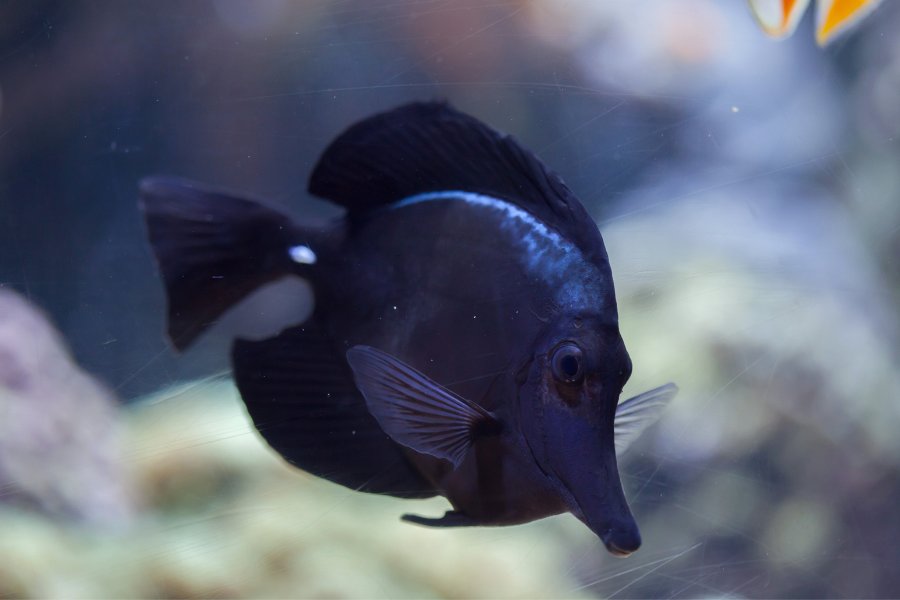
The black tang, also known as the black Longnose tang, is the rarest tang fish in the market. True solid black-colored fish are hard to come by, let alone a tang blackfish.
It is uniquely colored with a solid black base color, a long snout, and black eyes, and about 10 inches in length. It is commonly distributed across the South Pacific.
It is not among the best since it is hard to come by, and that translates to a higher price tag, albeit a great addition to your aquarium collection.
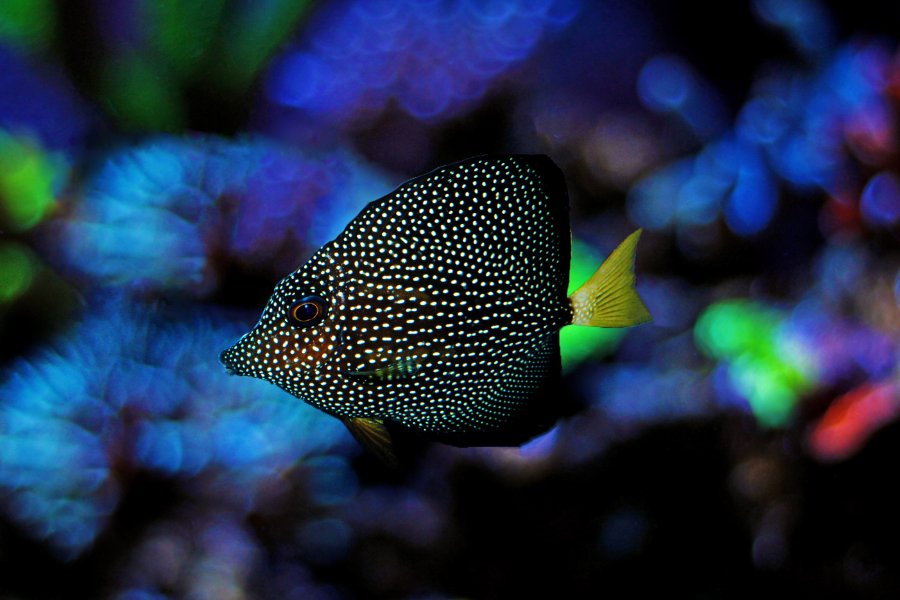
A rare close second is the Gemmatum Tang (Zebrasoma gemmatum). It also has a black base color but includes vibrant galaxy-spaced white spots across its entire body that remind you of the night sky.
With their rare nature in mind, the Gemmatum Tang and Black Longnose Tang are the most expensive tang fish. Gemmatum Tang prices start from $999 (one fish, 2-3 inches long), while the black tang prices are higher, starting from $1500 (one fish, 2-3 inches long).
Also Read:
Final Thoughts
As you can tell, tangs are colorful fish that are beloved for their captivating appearance that you’re your aquarium pop with life and shimmer.
As easy as it can be to care for these hardy fish, it is important to remember that they are prone to diseases, particularly the marine ich and Hole in the Head (HITH).
You can greatly prevent these diseases and extend the tang’s life by keeping staple water parameters, giving them enough food, and sticking to the proper diet- little meaty foods, lots of marine algae, and lots of plant-based foods.
